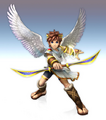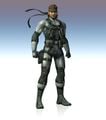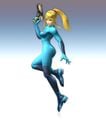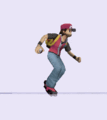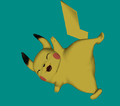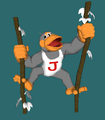Unused content (SSBB)
The following unused content is known from the development of Super Smash Bros. Brawl.
Fighters
Masahiro Sakurai himself stated that there were several more characters planned to be included in Brawl, but were cut due to time constraints, though he could not divulge which characters specifically were cut[1]. Both leftover data in Brawl's code and interviews conducted after its release have been partial indications on the identities of these characters.
Discovered in Brawl's files
Multiple unused character data files were found in the disc. Sometimes colloquially referred to as "The Forbidden Seven", they consist of (in the order in which they appear in the game's files):
As the files themselves are empty, the filenames are the sole indication of their identities. Despite this, it can be argued that there is little ambiguity over them:
- The identity of "pra_mai" is uncertain. While commonly theorized to represent the Pokémon characters Plusle and Minun, as their Japanese names are pronounced as Purasuru and Mainan, the Ice Climbers have separate character files for the two characters. In addition, each of the other Pokémon use their official transliterated Japanese names in the game's files (for example, Mewtwo is used in the game's files, rather than the Japanese pronunciation of the name, Myūtsū), and Plusle and Minun's Japanese names are Prasle and Minun. The in-game trophy for Plusle and Minun is also labeled as "prasle" and "minun" in the code, further disconfirming the two Pokémon. "pra_mai" has also been theorized to represent "Every Player", as Mai can be translated from Japanese to English to mean "every", while Pra can be seen as a shortening of the word "player". "Every Player" has been theorized to be either a slot for the Random button on the character selection screen, or to represent Miis.
- "mewtwo" can be reasonably assumed to be Mewtwo, who appeared in Melee. "mewtwo" has the most unused data out of the other scrapped characters, all of which are empty: an unused fanfare, a graphics effect file (
ef_mewtwo.pac), and a Wii Remote selection sound. As Mewtwo is an arguably unjustified cut for being the only removed character to not be a clone, this suggests it was strongly intended for inclusion in Brawl, but later did not make the final cut to the roster. - "roy" can be reasonably assumed to be Roy, who appeared in Melee. While lacking some data compared to "mewtwo", "roy" has both a graphics effect file (
ef_roy.pac) and an unused fanfare, suggesting the character was also strongly intended for inclusion in Brawl, but later did not make the final cut to the roster. - "dr_mario" can be reasonably assumed to be Dr. Mario, who appeared in Melee. However, compared to files for "mewtwo" and "roy", "dr_mario" has the least data available, having only one unused character file (
ef_dr_mario.pac).- Mewtwo and Roy later made a reappearance in Smash 4 as downloadable characters, while Dr. Mario also returned in the base roster. After the release of Smash 4, it was discovered that several of Dr. Mario's data files are named "mariod". This name matches a set of files found in Brawl's data; they mostly contain either duplicates of Mario's data or blank space, and were originally assumed to be a debug version of Mario. Along with the fact Dr. Mario's moveset is cloned from Mario in all his playable appearances, this suggests that Mario's data was replicated to recreate Dr. Mario early in Brawl's development, but no differentiation was done at all.
- "toon_zelda" and "toon_sheik" can be reasonably assumed to refer to a cel-shaded Zelda that appeared in games such as The Legend of Zelda: The Wind Waker, much like Toon Link. There has never been a cel-shaded variant of Sheik that appeared in the Zelda series prior to or after Brawl's release; it is commonly theorized that "Toon Sheik" may have been another name for Tetra, Zelda's alter-ego in The Wind Waker. However, there was never a Twilight Princess incarnation of Sheik prior to Brawl, so it's every bit as likely to have been a Wind Waker version of Sheik in a similar manner. The name "Toon Zelda" would be first used officially years later in Hyrule Warriors Legends, referring to the similarly-designed Zelda from The Legend of Zelda: Spirit Tracks. It should be noted that the Zelda (Wind Waker) trophy is not actually referred to as "toon_zelda" in the code of the game. In comparison, the trophies for Mewtwo and Dixie are referred to as "mewtwo" and "dixie" respectively.
- "dixie" refers to Dixie Kong, a major character from the Donkey Kong Country series. According to Sakurai, Dixie Kong was intended to be teamed with Diddy Kong, so the two could be tagged out for each other in the midst of battle, similar to how they played in Donkey Kong Country 2: Diddy Kong's Quest; the idea, however, was cut after he ran into technical issues with implementation of the idea, and Diddy Kong was left as a solo fighter in Brawl.[2] No other data for Dixie has been found, with the exception of her associated trophy and sticker.
The inclusion of the character files led to the formation of a rumor that was later proven false.
Considered
- Pac-Man was reportedly requested by Shigeru Miyamoto to be the third third-party character in Brawl, but Masahiro Sakurai, thinking of Pac-Man's iconic "pizza-shaped" design, denied the request as it seemed far-fetched.[3]
- A Villager from Animal Crossing was considered as a character in the planning stages of Brawl, but was ultimately dropped, as Sakurai felt such a character "wasn't suited for battle".[4] Villager and Pac-Man both later joined the roster in Smash 4.
- A Nintendog was considered to be playable in Brawl, but was not included because Sakurai felt that it was not ready for battle and would work better as an Assist Trophy in the game[5].
- Miis were considered as a playable character in Brawl, but were ultimately not included because Sakurai felt that "it didn't seem right at the time for Miis to be punching and kicking". They were also cut due to online bullying and concerns that they would be uninteresting to go up against.[6][7] Miis later became playable in Smash 4, as part of three different potential fighting styles. In Smash 4 Miis were not playable online, while Ultimate allows them to be played online, albeit without visible nicknames.
- Geno was considered for inclusion in Brawl, as Sakurai knew about the character's popularity, and he also felt that Geno could easily fit the universe of the games. Plans for his inclusion, however, ultimately fell through, presumably due to rights issues involving Square Enix, who own the rights of Geno.[8] While he has not appeared in the series proper, he is given representation as a Mii Gunner outfit released as part of Wave 5 of the downloadable Mii Fighter costumes in Smash 4, and as a spirit in Ultimate. The Mii outfit from Smash 4 was readded to Ultimate with updated textures alongside Sephiroth.
- Blastoise was considered as part of Pokémon Trainer's team, but it was ultimately replaced by Squirtle, as Sakurai felt that Squirtle could "establish itself as a character better than Blastoise," as well as feeling that having a sense of "balance" involving the size and stages of the Pokémon Trainer's various Pokémon would make the character feel deeper[9].
- When Sonic was in the planning stages, Sakurai decided between different games on where to source his moveset. He noted he would have come up with a different moveset if he focused on more recent games, but decided on the Mega Drive games. [10]
- Krystal from Star Fox was considered as a playable character, but she was ultimately rejected due to development time concerns, as little of the pre-existing knowledge involving Fox and Falco's models could be applied to her new, theoretical model. Wolf was ultimately included over Krystal, as his own model could rely more on Fox and Falco's models.[11] Krystal would eventually be included in the Assist Trophy roster in Ultimate, patterned after her debut appearance in Star Fox Adventures.
Stages
- Similar to some Melee early screenshots, the initial Pokémon Stadium 2 had no graphics on the jumbotron in the background.
- Shadow Moses Island also had an outdoors area; while Snake can briefly be seen in it from the Nintendo World Report 2007 trailer, it can only be seen via hacked cameras in the final game.
- In the E3 2006 trailer, Snake's cardboard box can be seen in the background of the stage when the Nintendog appears; this does not occur under normal circumstances in the final game.
- Additionally, Battlefield had no upper platforms when the Nintendog appears, showing us a flat version of the same stage.
Notice how the jumbotron behind Pokémon Stadium 2 is blank, while this never happens during normal gameplay in the final version.
An early screenshot of Shadow Moses Island, depicting a location inaccessible in the final version of the game.
Gameplay
- Some of the series symbols were initially the same as in the previous two games, but they were revised as time went on; the Mario series mushroom icon was refined and given spots, the Poké Ball icon has the top half colored in to properly represent how it is usually red, the Screw Attack icon was given more bends and another outline, and the Yoshi egg's angle was changed, with a slightly different arrangement of spots.
- Characters seen in E3 2006 and Nintendo World 2007 had different game renders than the ones in the final product. Most have their poses remain identical, but with emphasis on the shading of design; meanwhile, Snake's pose is completely different and has slightly different coloration.
- Multiple characters had their attacks changed between the game's development and release:
- Kirby, in the E3 2006 trailer, is showing attacking in midair with his Hammer as he did in Melee. However, the final build instead shows Kirby spinning horizontally. Kirby also has unused animations of him walking with his hammer, along with releasing it with full force; this suggests Kirby's hammer was to have a mechanic that allowed it to be charged. In the final build, King Dedede has a similar ability with his Jet Hammer. This option was finally given to Kirby in Super Smash Bros. 4, with the ability named Hammer Flip.
- In the Nintendo World 2007 trailer, when Fox appears, he has his Blaster in his hand during the whole battle despite the fact in the final release he only uses the blaster when using his standard special move. Additionally, animations left in the game data show both Fox and Falco inspecting the environment before putting their blasters away; they appear to have been intended for a mechanic where overusing the Blaster would cause it to overload or misfire.
- Link's Spin Attack was also changed over time. In the first and second trailers, it is given the appearance that there are two strikes on top of each other; in the final game, however, there is only one strike. The early Spin Attack also lacked the red overlay on the slashes.
- Pikachu's Quick Attack was also altered; in the first trailer it is shown making 2 "bip" sounds, one with each teleport as in Melee. However, in the final version, the sound was altered significantly, and it only makes one sound, on the first teleport.
- Wolf was found to have a unused animation that matches the infinite rapid kick of Fox's jab, suggesting that Wolf was originally intended to be more of a clone of Fox, before being decloned later in development to the point of not even being a semi-clone.
- Snake, in particular, had many differences from the final product. In early screenshots, he is shown grabbing some characters with more accuracy. One picture shows Snake grabbing Ike from his right arm and mouth (similarly to how he can kill enemies from behind in the Metal Gear series), but in the final version every character gets grabbed by the head. Snake's mines also were considerably more realistic-looking, sporting a drab, dark grey-green look instead of the light grey seen in the final game.
- In trailers, characters were also shown to be Blast KO'd after they crossed the upper blast line. In the final game, normal characters can only be KO'd this way in the Subspace Emissary. This idea would later be implemented into Super Smash Bros. 4 and Super Smash Bros. Ultimate, where all characters have a random chance of being Blast KO'd via the upper blast line.
- E for All 2007 had a playable demo of Brawl available. This demo was lacking several starter characters: Kirby, Zelda/Sheik, Pokémon Trainer, Ice Climbers, King Dedede, Wario, Olimar, and Lucas are all starters in the final game, but were unavailable in the demo. The demo did, however, allow Sonic to be playable from the start, to celebrate him being announced in October 2007.
- The character Perry from Super Princess Peach was intended to appear as part of Peach's moveset, where she would use him as a parasol rather than her own in the final game. His trophy textures (PeachTexC through PeachTexF) are named after Peach's textures, and Peach's parasol model (WpnPeachKassar) contains his Japanese name, (カッサー, Kassā).
- Certain characters (specifically, those equipped with weapons or armor) have unused textures that depict physical damage done to them. By examining said textures, it is shown that visible battle damage was at one point planned to be in the game. Meta Knight has a mask texture with large gashes over his helmet, and Captain Falcon has a cracked visor that would've revealed his face (as evident by the unused eye texture he has). Other textures suggest that even swords would've been breakable.
- In an article released shortly after Brawl,[12] Sakurai stated the cracks and gashes were originally planned to be part of a much larger game mechanic, one that involved the breaking of character equipment which would have cause skilled players to be in a disadvantage because character equipment like swords would only return after a stock. While the mechanic was never implemented, the textures incorporated for them were, as seen in the Final Smash trophies of certain characters and the false characters of the Subspace Emissary (however, the glow around them makes it barely noticeable). Visual damage would later be incorporated in Super Smash Bros. for Wii U, as seen in Little Mac, and later Olimar and King K. Rool in Super Smash Bros. Ultimate, when they sustain enough damage and, in Olimar's case, gets Screen KO'd. Weapon durability would later become a feature with Robin in Smash 4 and Steve in Ultimate.
- There also exists some unused palette swaps for characters on the game's disc. One such unused costume was a blue-colored Luigi, under the name FitLuigi02.pac/.pcs. Unusually, this costume has its shadow model integrated into the primary model, rather than having it as a separate model.
- An unfinished Assist Trophy file with Ridley's name exists, meaning Ridley was originally planned to be an Assist Trophy; it is likely that this idea was scrapped in favor of making him into a boss. [13]
- Like the first two games, most characters were planned to grunt when they were hit by a strong attack that resulting in medium or high knockback. However, characters only grunt after a second in the actual game, preventing these yells from being heard. These sound effects can still be found within Brawl's data, and they later returned in SSB4 for heavy knockback if the character reused their old voice clips, however, these will only play for heavy knockback as the Screen KO in that game is silent.
- The announcer counted down the final ten seconds of the match in every battle.[citation needed] This was reduced to five seconds in the final game.
- The announcer additionally has an unused line for speaking the name of the game at the end of the opening movie. Pat Cashman even stated he was unsure why this was removed from the final version.
Solo
- Multiple scenes in the Subspace Emissary were cut due to time constraints, which leaves some parts of the story out; however, an update on the DOJO!! explained these removed cut scenes. Among the explanations include how the Subspace Army takes over the Halberd and King Dedede unintentionally stalls Meta Knight from preventing it from happening.
- A TV spot for Brawl also shows Mario instead of Kirby fighting Petey Piranha. This is likely because Petey was originally supposed to blast Kirby out of the arena, making players use Mario to duel him, although Mario and Kirby switched roles later. However, after completing the Subspace Emissary, players can revisit Midair Stadium using any character (including Mario) and face Petey.
- The font for enemies in the developing Subspace Emissary was slightly different and considerably more spaced out. Additionally, a early screenshot of "The Battlefield Fortress" shows a considerably less overcast and brighter sky.
- An early classic mode screen appears in the ISO file as well. Unusually, it uses a sound effect from Melee.
- In a screenshot of Brawl's Classic Mode on the DOJO!!, a battle against giant Meta Knight is depicted with two allies, whereas in the released version of Brawl, there is only one ally on the Kirby stage in a giant battle there. Additionally, no giant battles past stage two give the player two allies.
- The Pokémon Trainer has unused jumping, falling, and landing animations that one can presume were intended to be used for traversing stages. In the final game, he simply Space Jumps when his Pokémon gets too far offscreen. This animation was later used in Super Smash Bros. Ultimate when playing as Pokémon Trainer in the hub world in Adventure Mode: World of Light
- A file inferred to be part of controlling menu and display elements for the Subspace Emissary contains an unused display element, labelled "InfAdvLevel0000", which appears to display a level number and a bar labelled "pp" which is animated from full to empty in 50 frames. Based on other filenames its purpose appears to have been to display a level number before beginning the stage.
A less gloomy version of The Battlefield Fortress.
Names
- Wario Bike, Drill Rush, Summit, Halberd, Rainbow Cruise, and "Flower Blooms in the Echoes" were originally called Wario Chopper, Triple Dash, The Summit, Battleship Halberd, Rainbow Ride, and, "Flowers Bloom on the Notes" respectively. It is unknown why the names were changed, although Rainbow Ride was likely changed because it was a Melee stage that had been misnamed "Rainbow Cruise" in that game (although it remains "Rainbow Ride" in the PAL regions, again because it was called "Rainbow Ride" on the PAL version of Melee).
- The description for the My Music options originally said, "Adjust how often a song will appear on this stage." It has since been revised in a general tone to say, "Adjust how often songs appear on stages." Along with this, one piece of music that was planned for the Delfino Plaza stage was later moved to Luigi's Mansion, that track being Castle / Boss Fortress (Super Mario World / SMB 3).
- One minor change was made to the Friend roster before release. In a pre-release version of Brawl, the friend roster would display friends as "on-line" and "off-line", but in the final release, the hyphen was removed. This meant that the friend roster would instead display friends as "online" and "offline".
An early version of Delfino Plaza's My Music with a track later moved to Luigi's Mansion.
An early version of the sticker album.
An early version of the Friend roster.
Masterpieces
- In all versions of the game, a Masterpiece of Donkey Kong Country was intended to be in included.
- In the American and PAL versions, Masterpieces featuring Fire Emblem: Mystery of the Emblem and EarthBound are believed to have been planned to be included, as their data is found on the disc. Another theory, however, is that the games were simply leftover data from importing the data of the Japanese version. EarthBound was later a masterpiece in Super Smash Bros. for Wii U.
Sounds
- Sound effects from the Melee version of Link's special moves can be found in the game's data, possibly as a placeholder until new sound effects were made.
- Unused sound effects can be found in Mr. Game & Watch's sound folder. These sound effects are distinctly different than Mr. Game & Watch's usual sound effects, as they aren't comprised of bleeps but rather unusual noises.
- Multiple characters have unused victory quotes that can be found in the game files, such as Captain Falcon saying "Yes!" in a more calm manner, Meta Knight saying "Now, my power is without rival.", Pikachu shouting "Pikapi!", and Sheik doing a victory cry.
- Ike has two unused voice lines for his Counter where he says "Gotcha!" and "You're through!" upon activation. In the final game, Ike only says "You're open!" when his counter is successful.
- Ike saying "Gotcha!" can still be heard in his Sound Test.
- Lucario saying "The Aura is stored." can be found in the game files. The quote is grouped next to the quote where Lucario says "Watch the power of the Aura!", implying it was going to be another voice clip for Aura Storm his Final Smash.
- Oddly, the voice clip sounds unusually choppy for unknown reasons. It is most likely this is the result of data corruption or possibly different parts of Lucario's voice clips combined and as such why the voice line isn't included.
- The Announcer has two unused narrations for "Fighting Alloy Team" and "Stage Clear". They were undubbed in PAL regions.
- More sounds like one of Mario's grunts, Pikachu screaming, and one of Zelda's grunts are in the Sound Test. Others like Pit saying "Here we go!" and Snake saying "There!", are in the games files, but missing in the Sound Test.
- Some of these sounds are later used in subsequent games; Meta Knight in Super Smash Bros. 4 uses one of his unused yells for his down smash, and Snake in Super Smash Bros. Ultimate may say "There!" when detonating the C4.
Music
Within Brawl's game data, many unused and empty music files have been found on the disc. The reason that they were removed is unknown, though it is commonly believed that some tracks were removed due to copyright issues, limited space, or simply personal preference by the developers.
All track files in this list are "empty"; that is, they do not produce any sound when played back. Much like the unused character files in the game, this leaves only the filename to determine what the music track was intended to be. However, the more equivocal filenames make it more difficult to determine the specific cut tracks.
It should be noted that the songs in this section, as all the songs used in the final product, follow a chronological trend.
| File Title in Brawl's code | Category (based on prefix) | Track Identity Theories |
|---|---|---|
| snd_bgm_A11_MLRPG02 | Mario | Unknown track assumed to be from Mario & Luigi: Partners in Time (titled Mario & Luigi RPG 2×2 in Japanese). |
| snd_bgm_A12_MORINOKINOKO | Mario | Japanese translates to "Forest's Mushrooms"; due to its position in the list, which follows a general chronological trend, it is possible this track was the theme for Toadwood Forest, also from Partners in Time. The title is also similar to "Beware the Forest's Mushrooms", a piece of music from the Square-developed game Super Mario RPG: Legend of the Seven Stars, but it is unlikely to be this track due to Nintendo and Square Enix not collaborating at the time, and due to the chronological order placing it closer to tracks from Partners in Time. |
| snd_bgm_C06_KAZENOSAKANA | The Legend of Zelda | Japanese translates to "Ballad of the Wind Fish", a notable track from The Legend of Zelda: Link's Awakening, as well as an unrelated track from The Legend of Zelda: Majora's Mask. Because it is placed before "Tal Tal Heights", also from Link's Awakening, it is assumed to be from the former game. |
| snd_bgm_E04_COCKIE | Yoshi | Unknown track assumed to be from Yoshi's Cookie. |
| snd_bgm_G06_COMMAND | Star Fox | Unknown track assumed to be from Star Fox: Command. |
| snd_bgm_J01_STAGECHANGE | Fire Emblem | Assumed to be used for the stage transitions for Castle Siege. Others assume that it may have been a stage transition theme from a Fire Emblem series game, similar to "Preparing to Advance". |
| snd_bgm_J05_ERABARESHI | Fire Emblem | Assumed to be a shortened form of the Japanese "Erabareshimono-tachi" (選ばれし者達), which translates to "The Chosen Ones", a track from Fire Emblem: Mystery of the Emblem. |
| snd_bgm_K02_SENTOUONIISAN | Mother | "Sentouonii-san" is the Japanese name for the New Age Retro Hippie, an enemy from EarthBound whose battle theme is similar to one from Mother, where a similar enemy also appeared. |
| snd_bgm_K03_EIGHTMELODIES | Mother | "Eight Melodies", a term describing two different tracks: one from Mother and one from EarthBound. |
| snd_bgm_K04_SMILEANDTEARS | Mother | "Smiles and Tears", the ending theme from EarthBound, which is based on the game's "Eight Melodies". This song would later be remixed for Super Smash Bros. 4. |
| snd_bgm_K06_BECAUSE | Mother | Assumed to be "Because I Love You", a track from EarthBound. Notably, this song is the basis of "Fourside" from Melee, which is absent from this game. |
| snd_bgm_M14_WARIOSTAGE | Wario | Track of unclear origin in the Wario universe. It is placed between two of WarioWare, Inc.'s microgame themes. |
| snd_bgm_N04_RADIOTAISO | Animal Crossing | The Japanese "Radio Taisō" translates to "Radio Exercises," a track from Animal Crossing. |
| snd_bgm_Q03_SPORTSMEDLEY | NES/GameBoy tracks | Assumed to be a medley of tracks from the generic sports titles on the NES, such as Soccer. |
| snd_bgm_R01_WILDTRACKS | Miscellaneous tracks | Japanese name for the game Stunt Race FX; assumed to be a track from that game. |
| snd_bgm_S01_MAINTHEME | Metal Gear | Assumed to be the main theme of a Metal Gear game; as it is placed before "Encounter" from Metal Gear Solid, it is most likely the main theme of that game. Likely not included due to plagiarism accusations related to the theme.[14] |
| snd_bgm_S09_BEATMANIA | Metal Gear | Assumed to be the remix of the Metal Gear Solid main theme from Beatmania. Likely not included for the same reason as the above track. |
| snd_bgm_T04_HOWTOPLAY | Super Smash Bros. | Assumed to be a duplicate file of the "How to Play" music. |
| snd_bgm_U05_UCANDO | Sonic the Hedgehog | Assumed to be "You Can Do Anything", a track from non-North American releases of Sonic CD (which used "Sonic Boom" instead). |
| snd_bgm_W22_DX55 | Super Smash Bros. | A removed track from Super Smash Bros. Melee -- the 55 may suggest that it was a rip of the Melee version of "Menu 2," track #55 in that game's Sound Test. Another hypothesis is that it was to be one of the other tracks from Melee to not be present in Brawl, such as "Fourside" or "Yoshi's Story". |
| snd_bgm_W32_DX81 | Super Smash Bros. | Assumed to be another removed track from Melee. It is unclear what the track was specifically meant to be, as Melee's sound test only has 80 tracks. |
| snd_bgm_X12_SIMPLEINTRO | Super Smash Bros. | Assumed to be used in the intros for Classic Mode. |
| snd_bgm_X14_ENDING | Super Smash Bros. | Assumed to be used in the endings for Classic Mode. |
| snd_bgm_X24_HOW2PLAY | Super Smash Bros. | Assumed to be another track for the How to Play video. |
Along with the above music files, the following unused songs were also found in the data, intended for use in the Subspace Emissary:
- snd_bgm_Y06_ADV06
- snd_bgm_Y12_ADV12
- snd_bgm_Y18_ADV18
- snd_bgm_Y19_ADV19
- snd_bgm_Y20_ADV20
- snd_bgm_Y21_ADV21
- snd_bgm_Y22_ADV22
- snd_bgm_Y23_ADV23
- snd_bgm_Y24_ADV24
- snd_bgm_Y25_ADV25
- snd_bgm_Y26_ADV26
- snd_bgm_Y27_ADV27
- snd_bgm_Y28_ADV28
- snd_bgm_Y29_ADV29
- snd_bgm_Y30_ADV30
The files could either have been background music (mainly because there few tracks that are exclusive to the Subspace Emissary), or as fanfares. It is unknown what they were meant to be used for.
Additionally, this trailer features a unique remix of the main theme, not found in the game files, that is seemingly a modified amalgamation of Menu 1 and the opening theme.
Victory Themes
Among the unused music files are various victory themes that are specifically attributed to one character, suggesting that characters were supposed to have their own victory theme independent of their series. However, they are completely empty. In the final product, only Meta Knight has a different fanfare than other characters of his universe; Super Smash Bros. 4 would eventually add alternative fanfares to more characters like Dark Pit, Bowser (in addition to Bowser Jr.) and Rosalina & Luma. Ultimate adds additional victory themes for Corrin, all Fire Emblem Awakening characters, Byleth, all Metroid villians, and Sephiroth; Piranha Plant also gains Bowser and Bowser Jr.'s victory theme.
Of note is that two of these unused fanfares, snd_bgm_Z38_FMYU2 and snd_bgm_Z39_FROY, refer to two unused character files in the game, those characters being Mewtwo and Roy respectively. Strangely, Wolf is missing an unused fanfare despite being from a returning series, likely due to his late inclusion. The files are as follows:
- snd_bgm_Z09_FLUIGI
- snd_bgm_Z12_FKUOPA
- snd_bgm_Z13_FPEACH
- snd_bgm_Z14_FZELDA
- snd_bgm_Z15_FSHEIK
- snd_bgm_Z19_FFALCO
- snd_bgm_Z20_FGANON
- snd_bgm_Z24_FZEROSAMUS
- snd_bgm_Z26_FLUCAS
- snd_bgm_Z27_FDIDDY
- snd_bgm_Z28_FPOKETRAINER
- snd_bgm_Z32_FDEDEDE
- snd_bgm_Z33_FLUCARIO
- snd_bgm_Z34_FIKE
- snd_bgm_Z37_FPURIN
- snd_bgm_Z38_FMYU2
- snd_bgm_Z39_FROY
- snd_bgm_Z41_FTOONLINK
Along with this, there are two other unused fanfares, snd_bgm_Z52_JCLEAR1 and snd_bgm_Z53_JCLEAR2. Their intended use is unknown, though it is believed they could have been used as stage clear themes.
Trophies
Some characters have unused trophies with "R2" in the filename, showing them in various poses (most in possible gameplay poses, some not). It is possible that these were intended to be a third trophy for each character, similar to how every character in Melee has three trophies, and the concept was scrapped for an unknown reason. Some trophies are carried over from Melee. Most of them don't have the white part of the eyes. Out of all of the R2 trophies, Only 15 can be hacked by replacing the R1 trophies to the game. For unknown reason, Pikachu freezes the game if viewed.
Dread Kong, a boss from DK Jungle Beat.
A Helper Monkey from DK Jungle Beat.
Scrapped Enemies
The game's effects files show names for enemies initially planned to appear in the Subspace Emissary:
- ef_arrians
- ef_bladeknight
- ef_blossa
- ef_blowm
- ef_bonkers
- ef_brontoburt
- ef_bubot
- ef_byushi
- ef_dyeburn
- ef_gunnatter
- ef_karon
- ef_kyan
- ef_met
- ef_mizuo
- ef_ploum
- ef_torista
- ef_waddledee
- ef_waddledoo
- ef_whauel
- ef_wiiems
Only seven of those enemies were dubbed in the English version. Those are:
- Aliian
- Allians
- Blowm
- Bublit
- Mechaboom
- Melorin
- Plowm
"Allian" could have been either entirely unique alien-like creatures, or an early name for the Primids.
Notes:
- Five of the known cut enemies come from the Kirby series.
- The textures for Waddle Dee and Waddle Doo fall in line with the naming convention for enemy data, further suggesting this. As King Dedede can summon both of them, and they function identically as in the Kirby series, it is effectively possible their data became incorporated into his moveset during development.
- Two of the known cut enemies come from the Mario series; Karon and Met are the Japanese names of Dry Bones and Buzzy Beetle, respectively.
- Mizzo, Waddle Dee and Waddle Doo are the only cut enemies that appear in Brawl through other means (excluding Dry Bones, who appears as a trophy).
See also
- Unused content
- Unused content (SSB)
- Unused content (SSBM)
- Unused content (SSB4)
- Unused content (SSBU)
References
- ^ OMN News: Sakurai Cut Characters From Smash Bros.
- ^ https://web.archive.org/web/20140710133913/http://www.geocities.jp/bgrtype/gsl/words2/dairantosmabrax/smashbrothersx.html
- ^ https://mynintendonews.com/2014/07/03/miyamoto-requested-pac-man-in-smash-bros-brawl/
- ^ http://www.polygon.com/2013/6/26/4465706/masahiro-sakurai-discusses-mega-man-smash-bros-s-other-new-characters
- ^ http://sourcegaming.info/2016/04/29/duflupdate/
- ^ https://sourcegaming.info/2015/07/07/mii-fighters/
- ^ http://youtu.be/GisRY6h100U?t=4m
- ^ http://sourcegaming.info/2016/02/21/nintendodream3/
- ^ http://sourcegaming.info/2016/04/29/duflupdate/
- ^ https://sourcegaming.info/2016/07/24/sonic-the-hedgehog-joins-the-battle/
- ^ http://sourcegaming.info/2015/08/17/sakuraibrawlquestions/
- ^ http://sourcegaming.info/2015/08/17/sakuraibrawlquestions/
- ^ [1]
- ^ https://www.gamasutra.com/php-bin/news_index.php?story=21513



